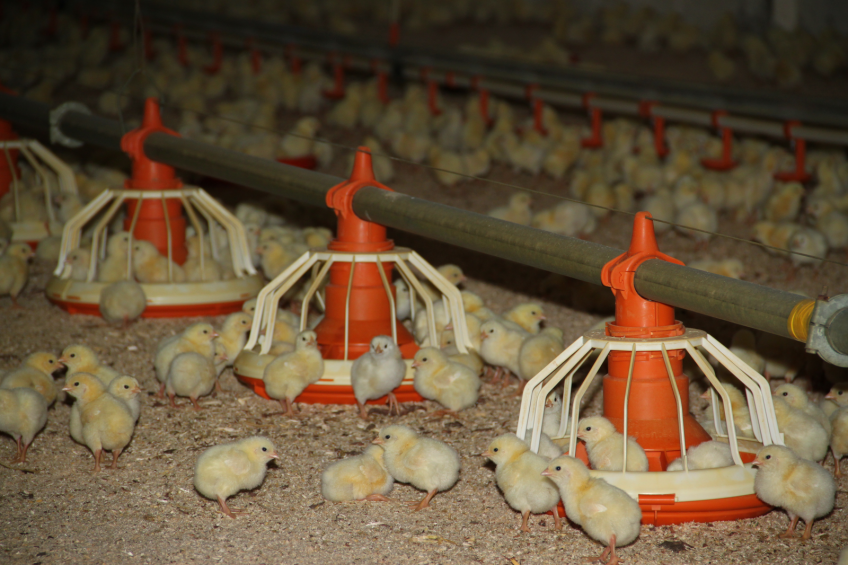Fighting pathogens with organic acid synergies

Management and hygiene are key to maintaining ?poultry performance. Although organic acids have been used to counteract pathogens in feed and water for many years, there is a growing need to assess and improve their continued effectiveness and sustainability.
By Renata Urbaityte, Biomin, Austria
Many poultry diseases cause substantial economic losses to the industry each year due to increased mortality or impaired growth. Colibacillosis caused by strains of E. coli organisms and avian salmonellosis, which includes a large group of acute or chronic diseases caused by Salmonella, are, in addition to many others, some of the most common causes of high economic losses.
Given that bacterial diseases in poultry also affect humans, and that epidemiologists suggest that poultry meat is a primary factor in human food poisoning, authorities and poultry producers are increasing their focus on disease control. Controlling these bacteria involves, among other things, improving monitoring systems, controlling the use of antibiotics, feed pelleting or improvements in management, and also maintaining high hygiene standards.
The most important physical parameters when it comes to the growth of microorganisms are pH, temperature and the presence or absence of moisture.
The acidity or alkalinity of feed affects the growth of pathogenic bacteria and most bacteria prefer a neutral pH of about 7 and will not grow at a pH below 4.5. Bacteria grow at a temperature range of 30-45°C. Newly hatched chickens have a body temperature of about 39.7°C and are usually kept at air temperatures of 30°C and litter temperatures of 28-30°C. Therefore, not only does the gastro-intestinal tract of the young broiler provide an ideal temperature for bacterial growth, the environment does too. Another factor needed for bacterial growth is moisture. Most feedstuffs contain sufficient moisture required for bacterial growth. Furthermore, bird droppings may increase the moisture levels of the litter.
The growth of microorganisms is more likely to happen in a nutrient-rich environment, such as that found in animal feeds. Feeds for young animals are especially rich in nutrients to meet the requirements for high protein deposition in the early stages of growth.
Various bacteria differ in their nutrient requirements. Bacteria require energy and derive nitrogen from amino acids, ammonia, creatinine and methylamines, as well as vitamins and minerals, including phosphorus, iron, magnesium, sulphur, manganese, calcium and potassium. In general, it can be said that the more complex the diet, the better it is for microorganism growth.
Management strategies key
Bacteria are present everywhere in the environment. The microbiota in an animal’s gastro-intestinal tract comprises both pathogenic and beneficial bacteria. The presence of pathogenic bacteria is not always a problem. However, in times of immune suppression or stress, or when bacterial numbers increase, pathogenic bacteria can become problematic. Therefore, it is important to strengthen a bird’s defence mechanism and to keep levels of pathogenic bacteria in the environment, and in the gastro-intestinal tract, low. This can be achieved through management strategies, such as improving welfare and hygiene. Good management includes not only making sure that welfare requirements are met, but also that nutritional needs are met.
Welfare and nutrition are, in fact, symbiotic. Even when the nutritional requirements are met, optimum growth will not be achieved if welfare requirements are ignored. If all these factors are addressed, birds will be less susceptible to pathogenic bacteria and morbidity and mortality will be lower. However, as mentioned, hygiene plays an important role in maintaining a bird’s health and, therefore, optimum growth performance. Pathogenic bacteria are constantly present but only become a problem when their levels increase. Thus, it is important to maintain a clean environment in which it is difficult for them to replicate, to minimise the bacterial challenge for birds.
Why fight the challenge?
Maintaining hygiene and reducing the bacterial load within feed and water is likely to result in improved growth performance. The lower the pathogen load in feed and water, the lower the bacterial exposure to the bird in general.
However, a full elimination of pathogens is impossible, particularly during times where birds are more susceptible to the challenge, for example at a young age or during stress. The host is, in general, competing with the bacteria for nutrients and a certain amount of energy, and other nutrients, such as amino acids, are lost to the microbiota in the gastro-intestinal tract. Furthermore, bacteria may secrete toxic compounds, decrease nutrient digestibility, and stimulate rapid turnover of absorptive epithelial cells. The presence of bacteria may also require an increased rate of mucus secretion by intestinal goblet cells and stimulate the immune system development and inflammatory responses. This all may result in impaired growth performance.
Organic acids helpful
While organic acids may provide the opportunity to reduce the bacterial load in feed and water, and hence reduce the intake of pathogens by the animal, fighting pathogens is still a challenge. Even though organic acids have a direct antimicrobial effect as they penetrate the bacteria in their un-dissociated form and exert adverse effects within the bacterial cell, combating pathogenic bacteria is still difficult.
This is especially so when it comes to Gram-negative bacteria as they have an additional outer membrane, providing them with an inherent protection against antimicrobial substances. However, this outer membrane can be damaged by so-called permeabilising substances. When permeabilising substances weaken the outer membrane of Gram-negative bacteria, the activity of antimicrobials is increased. Synergistic effects are produced when a permeabilising substance is added to a mixture of organic acids and a phytochemical. Feeding a mixture consisting of a blend of organic acids, phytochemical, cinnamaldehyde, and a permeabilising substance (such as Biotronic of Biomin) reduces the number of potentially harmful bacteria in the ceca of broiler chickens while increasing the numbers of beneficial bacteria (Table 1). Despite challenging conditions, growth performance was improved (Table 2) as birds had less competition with bacteria for nutrients and energy.
Bacteria resistance
Antimicrobials are essential tools for managing bacterial diseases and protecting animal health and welfare, as well as public health. Antimicrobial resistance refers to the ability of micro-organisms to withstand antimicrobial treatments. The widespread abuse or overuse of antibiotics on farm animals for growth enhancement has been linked to the emergence and spread of antimicrobial-resistant micro-organisms which has contributed to the escalating public health crisis of antibiotic resistance. In the EU, a strategy has been launched to combat the threat of antimicrobial resistance to human, animal and plant health. It includes the phasing out of antibiotics for non-medical use in animals, e.g. their uses in feed for growth promotion. Moreover, there has been evidence that natural feed additives which possess antimicrobial properties could be used as potential alternatives to antibiotic growth promoters.
Synergistic reactions
Numerous literature studies have shown that organic acids have a high antibacterial effect against Gram-negative bacteria. Combining organic acids with phytochemicals and permeabilising substances used against drug resistant Gram-negative bacteria intensifies the antimicrobial effect through synergistic reactions. It is highly recommended that organic acids be used in combination with substances having different antimicrobial or permeabilising properties as a part of a program to effectively fight against drug resistant bacteria in animal production.
Source: World Poultry magazine vol 29 nr 9, 2013
Join 31,000+ subscribers
Subscribe to our newsletter to stay updated about all the need-to-know content in the poultry sector, three times a week. Beheer
Beheer








 WP Admin
WP Admin  Bewerk bericht
Bewerk bericht